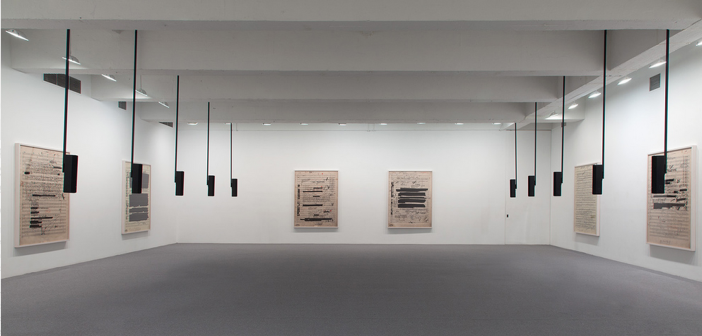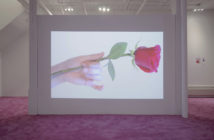Twelve narrow speakers are distributed evenly around the perimeter of New York’s Tanya Bonakdar Gallery. A solo violin sustains an E. Another violin comes in with an E-flat. The dissonance is disquieting, but so intense that few visitors can turn away. A ghostly murmur of lower tones interrupts, silenced by an attack of climbing pizzicati. There are traces of a melody but it cannot be made out. The music carries on a bit further then lurches to a stop again. Between the speakers, posters roughly five by six feet show hand-written sheet music covered over by blotted-out typewriting and FBI stamps. Visitors cannot sit still, as they would at a concert hall or cinema, the venues for which the music was originally intended. Partly due to the dispersion of speakers and visuals and partly to the anxiety caused by the eerie music and FBI files, one paces, exploring various corners of the room, standing next to a speaker, then moving to another. It is important for the artist, that the sound activates the space and encourages listeners to do the same with their bodies. At a certain point it becomes unclear whether you are following the music or it is following you.
The installation, Susan Philipsz’s Part File Score, is the third of her work that examines the devastation of human life and music in German history. The first was Study for Strings (2012), an eight-channel sound piece installed at the train station in Kassel, Germany, for the thirteenth Documenta exhibition. This work singles out individual notes of the viola and cello parts from an orchestral piece written by the Czech composer Pavel Hass while interned at the Theresienstadt concentration camp in 1943. Though Haas was murdered immediately after the piece was recorded for a Nazi propaganda film, the conductor of that performance survived the war and helped reconstruct the lost score. Visitors to that installation stood where deportations to death camps had taken place and listened to a fractured version of Haas’ composition, hearing more dissonance and silence than melody.
 Susan Philipsz: Part File Score
Susan Philipsz: Part File ScoreJanuary 8 — February 14, 2015
Courtesy the artist and Tanya Bonakdar Gallery, New York
A similar process of research and de-composition was integral to Philipsz’s 2013 sound installation in Düsseldorf, The Missing String, for which she challenged musicians to perform Richard Strauss’ Metamorphosen, composed at the close of WWII, on instruments that were missing a string. This already poignant piece was punctuated by the squeaking of war-damaged wind instruments Philipsz borrowed from German museums. Philipsz’s use of silence to evoke absence recalls John Cage, but whereas Cage employed silence as an anti-compositional device, Philipsz is interested in silence as a tool for exposing something that once had sound but is now lost to history.
Part File Score is based on Hanns Eisler. Eisler studied with Arnold Schoenberg in Vienna as Schoenberg was developing the twelve-tone system, which uses and emphasizes all twelve notes in the chromatic scale as equally as possible. Eisler moved to Berlin in 1925, drawing inspiration from jazz and cabaret, becoming a close collaborator of the playwright Bertolt Brecht, and composing scores for early film projects. When the Nazis rose to power in 1933 they banned Eisler’s music, featuring it alongside Schoenberg’s in the exhibition Entartete Musik ("Degenerate Music"). Eisler eventually obtained a permanent visa in the United States, teaching at the New School in New York City and in 1942 joining Brecht, Schoenberg, and other German exiles and émigrés in Los Angeles.
 Installation views
Installation viewsSusan Philipsz: Part File Score
January 8 — February 14, 2015
Courtesy the artist and Tanya Bonakdar Gallery, New York
Due to his siblings’ involvement in the Communist Party and his own Marxist orientation, Eisler suffered constant surveillance and persecution by the FBI and was subpoenaed twice to testify before the House Committee on Un-American Activities (HUAC). Ronald Reagan and J. Edgar Hoover poured over songs Eisler wrote and phone conversations he had but could prove neither that he was a member of the Communist Party nor that he had done anything to promote communism in Hollywood. Nevertheless, Richard Nixon claimed that Eisler’s case was among the most important ever to come before HUAC. Despite the best efforts of Eisler’s international supporters, including Charlie Chaplin, Thomas Mann, Pablo Picasso, and Leonard Bernstein, the FBI was adamant that he be deported. Eisler and his wife obtained an exit visa and escaped the United States in 1948, shortly before being forced out. Although Eisler returned to East Berlin in the newly erected Soviet zone of occupation and composed East Germany’s national anthem, the cultural authorities there continued to suspect Eisler of undermining the state and repressed or censored his output until his death in 1962.
Part File Score was first heard in 2014 at Berlin’s state-run contemporary art museum, the Hamburger Bahnhof, a former train station. As the work takes up the themes of exile and deportation, it is important that Philipsz again chose a train station as the site for her work. Part File Score in its complete form is a twenty-four-channel sound installation accompanied by a series of large-scale prints. The presentation at Tanya Bonakdar Gallery was reduced to twelve channels, nodding to Schoenberg’s twelve-tone system, which Eisler employed selectively. Philipsz manipulated excerpts from three of Eisler’s film scores from the 1920s and 40s, none of which exist entirely in their original form. For the most part, Philipsz, like the musicologists who have reconstructed these pieces, relied on archival versions of the scores, some of which are incomplete, and all of which are full of the composer’s own marginalia.
 Susan PHILIPSZ
Susan PHILIPSZPart File Score I
2014
Digital print and silk screen print on canvas
74 1/2 x 59 x 1 2/3 inches; 189 x 150 x 4.2 cm (framed)
Edition of 3, 2 APs
Courtesy the artist and Tanya Bonakdar Gallery, New York
In 1926, Eisler composed ‘Prelude in the Form of a Passacaglia’ to accompany Walter Ruttmann’s short abstract animation, Opus III (1924). Ruttmann hand-colored the film to suggest various moods, which Eisler’s music accentuated. This was Eisler’s first film music, written shortly after he relocated from Vienna to Berlin at the height of the Weimar period. The second piece Philipsz used is Eisler’s 1941 composition, Fourteen Ways to Describe Rain, composed for Joris Ivens’ 1929 film Regen ["Rain"], dedicated to Arnold Schoenberg, and central to Eisler’s research project with Theodor Adorno, Composing for the Films. Finally, Philipsz adapted Eisler’s ‘Septet No. 2’ (1947), which Charlie Chaplin commissioned for his film Circus (1928), originally Chaplin’s last silent film. Chaplin likely commissioned the piece to delay Eisler’s imminent deportation but Eisler was forced to return to Europe before completing the score.
In Part File Score, Philipsz tasked the violinist with recording separate tracks for each note in the three compositions. One track features every single E in the piece, played in rhythm, the next contains every E-flat, and so on. The lack of instrumentation and the interruption of one track into another render Eisler’s melodies bleak and unrecognizable. Although Philipsz describes her work with the score as "deconstruction," there is something composed about what the visitor hears. The result is eerie and cold, though not unpleasant.
The aural experience is complemented by the twelve large-scale digital prints of Eisler’s handwritten archival scores, which Philipsz overlaid with silk-screen prints of sheets taken from the composer’s FBI file. Eisler’s FBI file contains numerous blacked-out lines, while his archival scores are covered in notes. Eisler’s jottings on the unpublished film scores are confidential, intended for friends, much like the "confidential" stamps that cover the FBI documents. Neither Eisler nor the FBI intended their notations to be heard or seen in the form in which Philipsz offers them.
Rather than fully restoring the sound of notes and voices that have been quieted, Philipsz invites her audiences to the more difficult experience of silence. It may not always sound beautiful but it rings truer than other projects of historical recovery. Part File Score exposes what authorities have long wished to repress while preserving the gnarly scars of history.




